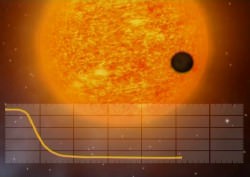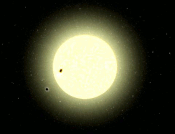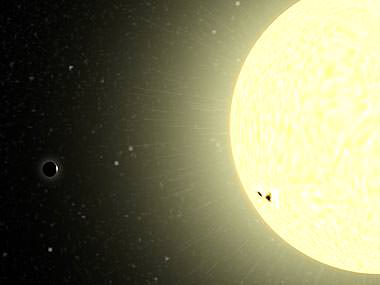[/caption]
The CoRoT satellite has found the smallest terrestrial exoplanet yet, — with a diameter just under twice that of Earth — complete with a rocky surface you could walk on and possibly even oceans to sail across. However, if you traveled there, you might want to bring some protection, as the temperature of this planet is likely very high. CoRoT-Exo-7b is located very close to its parent star, orbiting once every 20 hours. Astronomers estimate temperatures on the planet could be between 1000 and 1500°C and it possibly could be covered in lava or water vapor. This latest exoplanet was detected as it transited in front of its parent star, dimming the light from the star just enough to be noticeable.
The parent star lies about 140 parsecs from Earth, located about half way between the star Sirius in Canis Major and Betelgeuse, the red giant star in Orion.
The internal structure of CoRoT-exo-7b particularly puzzles scientists; they are unsure whether it is an ‘ocean planet’, a kind of planet whose existence has never been proved so far. In theory, such planets would initially be covered partially in ice and they would later drift towards their star, with the ice melting to cover it in liquid.

“This discovery is a very important step on the road to understanding the formation and evolution of our planet,” said Malcolm Fridlund, ESA’s CoRoT Project Scientist. “For the first time, we have unambiguously detected a planet that is ‘rocky’ in the same sense as our own Earth. We now have to understand this object further to put it into context, and continue our search for smaller, more Earth-like objects with COROT,” he added.
About 330 exoplanets have been discovered so far, most of which are gas giants likeJupiter and Neptune. The density of COROT-Exo-7b is still under investigation: it may be rocky like Earth and covered in liquid lava. It may also belong to a class of planets that are thought to be made up of water and rock in almost equal amounts. Given the high temperatures measured, the planet would be a very hot and humid place.

“Finding such a small planet was not a complete surprise”, said Daniel Rouan, researcher at the Observatoire de Paris Lesia, who coordinates the project with Alain Léger, from Institut d’Astrophysique Spatiale (Paris, France). “CoRoT-Exo-7b belongs to a class of objects whose existence had been predicted for some time. COROT was designed precisely in the hope of discovering some of these objects,” he added.
Small terrestrial planets are difficult to detect, and so very few exoplanets found so far have a mass comparable to Earth, Venus, Mars, and Mercury. Most of the methods used to find planets are indirect and sensitive to the mass of the planet. The CoRoT spacecraft can directly measure the size of a planet’s surface, which is an advantage. In addition, its location in space allows for longer periods of uninterrupted observation than from ground.
Astronomers say this discovery is significant because recent measurements have indicated the existence of planets of small masses but their size remained undetermined until now. CoRoT (Convection Rotation and Transits) was launched in December 2006 and consists of a 27 cm-diameter telescope designed to detect tiny changes the brightness of nearby stars. The mission’s main objectives are to search for exoplanets and to study stellar interiors.
Source: ESA


@trueman832: as well as what Don Alexander says, a sunspot is visible for approximately half the time, but a planet only transits for a tiny part of its orbit. So dips in brightness due to sunspots (and these have been detected before) are much longer than those due to transits, relative to the period that they occur.
I feel there’s an element of weasel-wording in the press release: as far as I know, this is indeed the smallest exoplanet for which the diameter has been measured (i.e., the smallest transiting exoplanet). However, I think planets such as Gliese 581c, which were detected by the radial velocity method, are probably less massive and smaller. We can’t be sure, because there’s quite a large uncertainty in the mass of CoRoT-Exo-7b, and the RV method only gives a minimum mass, but there are several of them and they’re unlikely all to be bigger.
Cool!
Congratulations to the CoRoT team, especially my colleagues Artie Hatzes, Bringfried Stecklum and Eike Günther, who were part of this great discovery!!
“The parent star lies about 140 parsecs from Earth…”
Shouldn’t that be light years?
“Shouldn’t that be light years?”
Unless it’s parsecs.
This planet’s year is 20 hours long? I’d imagine any life there would have died of exhaustion from all of the new year’s parties long ago. Although the market for novelty glasses and party hats would be fantastic.
So how do they tell transits like this from sunspots again? I know I ask this a lot, but nobody ever answers. Our sun takes 25 days to rotate fully, this star must be tiny.
How much time until they find a terrestrial planet in the habitable zone? I think as soon as the first Kepler results start to come in.
I have no doubt that the universe is full of life, once we understand how to detect them.
@trueman832: I’m not sure how well a transit light curve can be discerned from a rotating star with a big sunspot. But remeber sunspots are mutable. With a 20 hour year, it means you measure a lot of transits. And each looks the same. Then you will also have the radial velocity analysis. Why should the star be tiny??? Don’t know the exact type, but it’s not a red dwarf AFAIK. The stellar rotation is probably much longer than the planet’s year.
@Fst: An Earth-like planet in a habitable zone will need ~ 1 year per transit. That makes it VERY hard to find. And clearly impossible “as soon as the first Kepler results start to come in” – it would take at least several years of data on the same field to find one. Not to mention that today’s spectrographs, not even HARPS, could measure radial velocity variations.
Okay, as soon as the first results come in was too optimistic, but isn’t the mission primary objective to find terrestrial planets in the habitable zone?
I am finding hard to believe planets rotating around the star every 20 hours. Do we know the size of the star? and I wonder what is the speed of the planet?
This may not be a planet at all.
Or could it be multiple planets causing the dimming of the start instead of just one? but then again I guess it will not be a static time and different planet size.
Good work though.
JoeTO.
“Shouldn’t that be light years?”
One parsec equals 3.26 light years, so it’s about 456.4 light years from Earth.
Do we know the name of the parent star? I can’t seem to load that ESA article.
I’m pretty sure the catalog designation and coordiantes of the star will remain secret until the actual paper is published…
Coordinates are the “ultra top secret” stuff of the exoplanet community. 😉
@trueman832: beside to what Don Alexander wrote, practically all planets discovered with the transitional method, are then studied for radial velocity / axometry too, and since sun spots do not cause any wobbling, it’s not difficult to exclude them.
@Joe: I do not quite understand your reasoning. Why cna’t you imagine so fast rotating? Just because ther is no such planet in our Solar system? You can calculate the speed easily from the data available – check it here: http://exoplanet.eu/planet.php?p1=CoRoT-Exo-7&p2=b
@Celsiu1414 / Don Alexander: you can get the planet’s and star’s data on the same link. The website http://exoplanet.eu is kept up-to-date, with new exoplanets as soon as they get announced.
# Fst Says:
February 3rd, 2009 at 11:54 am
“Okay, as soon as the first results come in was too optimistic, but isn’t the mission primary objective to find terrestrial planets in the habitable zone?”
One of the missions primary objectives is to “Determine how many terrestrial and larger planets there are in or near the habitable zone of a wide variety of spectral types of stars”.
If they are going to find an Earth-size planet in another star’s habitable zone, then it will almost certainly be around a red dwarf or other small star where the habitable zone lies in close to the star. Then the planet will have a relatively shorter ‘year’, and they’ll be able to get a decent amount of data on it within the mission lifetime. Not to mention the greater likelihood of transits from our point of view actually occurring for a closer-in orbit.
Transit isn´t a usefull way to find planets! I know it presents some results but we can only find planets like this one, or those wierd hot jupiters.
I guess we will took some decades to find something in the analogue of earth orbit.
What’s the deal with the artists’ impressions? Several depict a crescent phase planet out in space and some sort of dark smudge on the star, and if one tries to parse the mangled English of the caption on the first image, it could be stating that the smudge is a shadow, which obviously doesn’t make any sense. Are these star spots, and if so is their presence in the images misleading?
Celsius 1414 wonders:
“Do we know the name of the parent star?”
It follows from the name of the planet, which is CoRoT-Exo-7 b – hence, the name of the parent star is CoRoT-Exo-7. That’s the naming convention: add b, c, d… etc. to the star’s name for planets in the order in which they are discovered.
“complete with a rocky surface you could walk on and possibly even oceans to sail across.”
WTF!? Who would want to walk on or sail on that planet??? Sensationalist. Cut it out.
Anyway, it’s great that they can detect such a small planets.
@Astrofiend, interesting point about red dwarfs, but they are dim. Wouldn’t that be a problem?
Dang, I thought it was going to be a little less difficult. I wish we could speed time up to see Kepler’s results, or even better, New Horizon’s Pluto pictures.
Am I the only one that sees a bit of a problem with the idea of this planet being covered in a liquid water ocean? Unless it has an atmospheric pressure several thousand times that of earth, I don’t think it’s very feasible.
Anyone have information I may be missing?
I came up with the same question. At 1250 degrees, the ocean would boil until it had all become vapour. Maybe the rockiness doesn’t preclude an unbelievably dense atmosphere forcing the water to superheat???
Could use some closer investigation.
nice. such food for the imagination.
Got this crazy idea. Why not send some signals to these few planets which has an extreme possibilities of holding life. Maybe they got they’re SETI & WETI to scrounge the vastness.